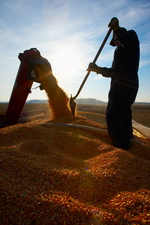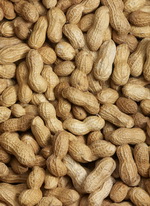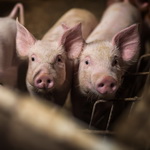 What happens if genetically modified (GM) crops were banned from US farm fields?
What happens if genetically modified (GM) crops were banned from US farm fields? CROP BIOTECH UPDATE
---------------------------------------------------------------------------
A weekly summary of world developments in agri-biotech for developing countries, produced by the Global Knowledge Center on Crop Biotechnology, International Service for the Acquisition of Agri-biotech Applications SEAsiaCenter (ISAAA)
---------------------------------------------------------------------------
March 2, 2016
In This Week’s Issue:
News
Global
• International Team Decodes Mesoamerican Bean Genome
Americas
• Researchers Find Molecular Marker for Calcium in Potatoes
• New Study Reveals Eliminating GMOs would Take Toll on Environment, Economies
Asia and the Pacific
• Study Shows Plants Forget Unused Memories
• Filipino Farmer Leaders Learn from Bt Brinjal Farmers in Bangladesh
• Genome Sequence of Cultivated Groundnut Completed
Europe
• Wageningen UR Develops Method for Selecting Plants with Better Photosynthesis
Research
• Overexpression of PslTIR1 in Tomato alters Fruit Shelf-life Characteristics
• Mutated Garlic Gene Expressed in Rice Confers Resistance to Sheath Blight
• Expression of Tomato Prosystemin in Tobacco Enhances Plant Resistance to Botrytis cinerea
Beyond Crop Biotech
• Bacteria Take "Mug Shots" of Threatening Viruses
• University of Missouri Scientists Breed PRRS Resistant Pigs using CRISPR
Announcements
• 5th International Conference and Exhibition on Metabolomics
• 3rd Plant Genomics Congress: Asia
----
NEWS
----
Global
INTERNATIONAL TEAM DECODES MESOAMERICAN BEAN GENOME
A team of scientists from Argentina, Brazil, Mexico, and Spain, through the Ibero-American Programme for Science and Technology for Development (CYTED) has decoded the genome of the Mesoamerican common bean (Phaseolus vulgaris).
The PhasibeAm team selected a specific MesoAmerican bean line for (BAT93) genomic sequencing, that is closely related to varieties that are commercially cultivated. The team established a robust technological platform, concluding with the sequencing and assembly of the 620 million base pairs. A total of 30,491 genes were identified in the genome and scientists also analyzed their expression patterns. They also observed and determined crucial events during evolution that have shaped the bean plant as it is known today.
Roderic Guigó, coordinator of the Bioinformatics and Genomics Programme at the Centre for Genomic Regulation in Barcelona, Spain said, "The sequence of the bean genome, both from the Andean variety, previously sequenced, and the Mesoamerican one, will definitively contribute to identify genes involved in disease resistance, drought and salt tolerance, nitrogen fixation, formation of reproductive cells and seed quality, among others."
The second phase of the project will involve sequencing the genome of at least a dozen other bean varieties and some of their close relatives to identify genes related to domestication.
For more details, read the news release at the Centre for Genomic Regulation website.
Early research shows that potatoes with dark or hollow spots are the result of calcium deficiencies in the potato and that tuber calcium is genetically linked to tuber quality. Consumers do not want these low calcium defects. Moreover, these potatoes are more likely to rot.
Most cultivated varieties of potatoes have naturally low levels of calcium. Researchers at the USDA-ARS and University of Wisconsin-Madison looked into wild potatoes to breed new high-calcium cultivars. The team found a wild potato with almost seven times as much calcium as a usual variety.
Researchers then proceeded to isolate the calcium trait by interbreeding the high- and low-calcium potatoes. The resulting generations showed a 'molecular marker' in the plant's natural DNA, leading researchers to the plant's calcium trait.
A typical breeding program grows and assesses up to 100,000 seedlings every year. However, the process simplifies with known molecular markers.
For more information, read the article at the website of Crop Science Society of America.
 What happens if genetically modified (GM) crops were banned from US farm fields?
What happens if genetically modified (GM) crops were banned from US farm fields?
A Purdue University study conducted by Wally Tyner, James and Lois Ackerman Professor of Agricultural Economics; Farzad Taheripour, research associate professor of agricultural economics; and Harry Mahaffey, agricultural economics graduate student, presented the significant crop yield loss and other economic effects of banning GM crops in the US.
The economists gathered data and found that 18 million farmers in 28 countries planted about 181 million hectares of GM crops in 2014, with about 40 percent of that in the US. They fed the data into the Purdue developed GTAPBIO model, to examine economic consequences of changes to agricultural, energy, trade and environmental policies.
The model showed that if all genetically modified organisms (GMOs) in the US will be eliminated, corn yield declines at 11.2 percent on average, soybeans lose 5.2 percent of their yields, and cotton at 18.6 percent. Around 102,000 hectares of US forest and pasture would have to be converted to cropland and 1.1 million hectares globally for the average case. Greenhouse gas emissions will increase significantly as more land is needed for agricultural production, and commodity prices will rise at 1-2 percent or $14 billion to $24 billion per year. With lower crop yields without GMOs, corn prices would increase as much as 28 percent and soybeans as much as 22 percent, according to the study.
For more details about this study, read the news release at the Purdue University Agricultural News.
A team of researchers from the Australian National University Canberra, has found that plants can reset a memory that has not been useful, and in essence, forgetting things that they have stored. Previous studies have shown that plants remember events such as droughts, so that they know how to survive if similar events occur in the future. In the new study, the team reports learning not only more about how such memory processing occurs, but also how plants are able to reset if conditions change such that a memory that has been learned that is no longer useful can be eliminated.
The researchers found that for a plant to create a memory, it has to create a protein that will have an impact on its own DNA, which allows for impacting future generations. It is all part of a process called RNA decay, where DNA strands are transcribed into RNA, before they are translated into proteins. The RNA decay process controls the amount of RNA molecules that are to be tuned into proteins, and any disruption to that process prevents a memory from being formed, suggesting the means by which previous memories may be eliminated. The process is important because holding onto memories uses plant resources.
The team notes that some plants also appear to have short-term memory that is not related to either DNA or RNA, but it still remains to be studied.
For more information, read the paper with details of the research at Science Advances.
Filipino farmer leaders participated in a two-day study visit to Bt brinjal (eggplant) farms in Bangladesh last February 23 to 26, 2016. Discussions on biotechnology regulations in Bangladesh, research and development of Bt brinjal, and farmer experiences on planting Bt brinjal were conducted with officials from the Bangladesh government and scientists from the Bangladesh Agricultural Research Institute (BARI). The activities included field visits to Bt brinjal planting sites, interactions with Bt brinjal farmers as well as Bt brinjal tasting. The activities were held in two villages in Bogra, Bangladesh.
Filipino farmers asked about the keys to success in the commercial approval and cultivation of Bt brinjal in Bangladesh. They also solicited insights and experiences that can help them communicate the plight of eggplant farmers in the Philippines to the government. Recently, the Philippine Supreme Court has permanently stopped the field trials of Bt eggplant, and nullified its operating regulations on research, field testing, commercialization, and importation of GM crops in the country.
The activity was the first interaction of foreign farmers with local Bangladeshi farmers and officials to share and learn from their Bt brinjal experience. Bangladesh released four varieties of Bt brinjal in October 2013. It significantly increased the marketable yield of brinjal fruits thereby mitigating losses caused by wastage of infested and damaged fruits. In just over a year, farmers have strongly accepted and have cultivated Bt brinjal. After the visit, the Filipino participants were further inspired to push for Bt technology in the Philippines as they were assured that the technology works and significantly benefits the farmers.

For more information about Bt eggplant in the Philippines, visit the website of the Southeast Asian Regional Center for Graduate Study and Research in Agriculture – Biotechnology Information Center or SEARCA BIC at www.bic.searca.org.
 The International Peanut Genome Initiative (IPGI), including researchers from the University of Georgia and the International Crops Research Institute for the Semi-Arid Tropics (ICRISAT), has completed sequencing the ancestral genomes of groundnut.
The International Peanut Genome Initiative (IPGI), including researchers from the University of Georgia and the International Crops Research Institute for the Semi-Arid Tropics (ICRISAT), has completed sequencing the ancestral genomes of groundnut.
The groundnut that is grown today comes from the hybridization of two wild species, Arachis duranensis (V14167, A-genome ancestor) and A. ipaensis (K30076, B-genome ancestor), cultivated in South America. To map the groundnut's genome structure, the researchers sequenced the two ancestral parents, and the sequences provide researchers access to 96% of all groundnut genes in their genomic context. A comparison of the DNA sequences of one of the wild species with the cultivated groundnut showed that they are 99.96% identical.
"Improving groundnut varieties to be more drought, insect and disease resistant using the genome sequence, can help farmers in developing nations produce more groundnuts with fewer pesticides and other chemicals and help these farmers feed their families and build more secure livelihoods," said Dr. Rajeev Varshney, Research Program Director – Grain Legumes and Director, Center of Excellence in Genomics at ICRISAT.
For more details, read the news release at the ICRISAT website.
Scientists from Wageningen University and Research Centre in the Netherlands (Wageningen UR) have developed the first ever method for accurately and simultaneously measuring the photosynthesis of nearly 1,500 plants.
The method uses an image analysis robot called the Phenovator, designed by Wageningen UR. Aside from photosynthesis, the robot also measures the growth and movements of plants during daytime and nighttime. The Phenovator also facilitates new fundamental research into issues such as the heredity of photosynthesis. It can also specifically search for genes that are relevant to photosynthesis. In addition, the Phenovator can be used to study the influence of other processes on photosynthesis, such as changes in light intensity, temperature or drought, and which genes are involved in such processes.
For more details, read the news release at the Wageningen UR website.
The release of auxin response factors (ARFs) from auxin repressors allows ARFs to mediate auxin-responsive changes in downstream gene transcription. To understand the role of auxin during fruit development, a plum auxin receptor, PslTIR1, was previously been characterized by researchers from the University of Guelph. The team used tomato (Solanum lycopersicum) to study the changes associated with the overexpression of PslTIR1.
PslTIR1 was found as a positive regulator of auxin-signalling in the development of leaves and fruits. This was manifested by the entire leaf morphology of transgenic tomato plants compared to the wild-types. Moreover, transgenic tomato plants produced parthenocarpic fruits, a characteristic property of auxin hypersensitivity.
Ethylene production associated with the ripening of fruits was not significantly altered in the transgenics. However, several genes encoding proteins involved in cell-wall degradation were upregulated, enhancing fruit softening rate leading to short shelf-life of transgenic tomatoes.
The study reveals the role of PslTIR1 in regulating leaf morphology, fruit development and fruit softening-associated ripening. These demonstrate that auxin accelerates fruit softening independently of ethylene action.
For more information, read the full article in BMC Plant Biology.
Rice sheath blight caused by Rhizoctonia solani is one of the most devastating diseases of rice and is associated with significant reduction in rice productivity. A mutant variant of mannose binding Allium sativum leaf agglutinin (mASAL) was previously reported to exhibit strong antifungal activity against R. solani. A team from Bose Institute in India, led by Prithwi Ghosh, evaluated the mASAL gene for its in planta antifungal activity in rice plants.
mASAL was expressed in an elite indica rice cv. IR64 through Agrobacterium tumefaciens-mediated transformation. Molecular analyses of transgenic plants confirmed the presence and stable integration of mASAL gene. Analysis of various tissue sections of plants indicated the expression of mASAL. In planta bioassay of transgenic lines against R. solani exhibited an average of 55% reduction in sheath blight percentage disease index (PDI).
This study presents the possibility of modifying rice plants with the mASAL gene for sheath blight resistance.
To learn more about the study, read the full article in BMC Biotechnology.
Systemin is a tomato peptide hormone that promotes plant defense against plant-chewing pests. Homologues of tomato prosystemin are present in other Solanaceae, but not in tobacco. Moreover, tobacco does not respond to the external application of the tomato systemin. Previously, it was shown that the expression of the full-length tomato prosystemin cDNA in tobacco increases plant tolerance against pathogenic fungi.
Giandomenico Corrado of Universitŕ degli Studi di Napoli Federico II in Italy led a team of researchers and evaluated the relevance of the systemin sequence. The team generated transgenic tobacco plants that express a mutated prosystemin lacking the systemin sequence region. Analyses showed that the constitutive expression of the truncated prosystemin altered the proteomic profile of tobacco leaves and increased plant resistance against Botrytis cinerea.
The overlap of the modifications caused by the expression of the full-length and the truncated prosystemin indicated that these alterations occur in the absence of the systemin sequence.
For more information about the study, read the article in Plant Cell, Tissue and Organ Culture.
Scientists from The University of Texas at Austin, the Stanford University School of Medicine and two other institutions have discovered that bacteria possess a system that recognizes and disrupts dangerous viruses using a newly identified mechanism involving RNA. The discovery might lead to better ways to thwart viruses that affect agricultural crops and production of dairy products.
The team found that bacteria can snatch bits of RNA from invaders, such as viruses, and incorporate the RNA into their own genomes, using this information like mug shots. They then help the bacteria recognize and disrupt dangerous viruses in the future.
Researchers now also study how to genetically engineer a crop so that their cells would carry this virus detector. Another application could be in the dairy industry, where viruses infect the bacteria that produce cheese and yogurt, causing the process to slow down or prevent it from completion.
For more information on the study, read the article on UT News.
 The porcine reproductive and respiratory syndrome virus (PRRSV) affects pigs worldwide and is considered the most economically significant disease of swine. Vaccinations have mostly failed to prevent the syndrome's spread, but a new approach by biologists at the University of Missouri may mark a turning point. They developed a commercial agricultural application for the revolutionary CRISPR/Cas9 gene-editing method—to breed pigs resistant to infection.
The porcine reproductive and respiratory syndrome virus (PRRSV) affects pigs worldwide and is considered the most economically significant disease of swine. Vaccinations have mostly failed to prevent the syndrome's spread, but a new approach by biologists at the University of Missouri may mark a turning point. They developed a commercial agricultural application for the revolutionary CRISPR/Cas9 gene-editing method—to breed pigs resistant to infection.
CRISPR/Cas9 is a gene-manipulation tool that allows scientists to make changes in DNA with razor-sharp accuracy. For porcine reproductive and respiratory syndrome, Missouri's Randall Prather, Kristen Whitworth and Kevin Wells used the technique to breed three piglets that lacked a protein in cells that acts as a doorway for the virus.
The edited piglets were grouped together in a pen with seven normal piglets, and were inoculated with PRRSV. After five days, the normal pigs grew feverish and ill, but the genetically edited pigs remained in top health throughout the study despite sharing close quarters with their sick pen mates.
Blood testing also revealed that the edited animals did not produce antibodies against the virus, proving that they evaded infection entirely. This work and other recent experiments demonstrate the promise of CRISPR/Cas9 for the care of domestic animals.
For more on the study, read the article on Scientific American.
What: 5th International Conference and Exhibition on Metabolomics
Where: Osaka, Japan
When: May 16-18, 2016
For details on registration, program, and abstracts submission, visit the Conference website.
What: The 3rd Plant Genomics Congress: Asia
Where: Kuala Lumpur, Malaysia
When: April 11-12, 2016
For more details, visit the Congress website.